Due to my epic journey back from the holidays in Canada and a week of grudgingly getting back into the swing of things at work, this post comes in a little late. Nevertheless, today’s entry was inspired by the recently expired New Year’s festivities, and the quintessential taste of January in Japan:
Mochi 餅
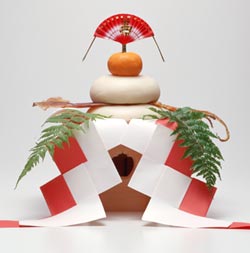
Mochi is a plump, sticky sort of rice cake made by pounding glutinous short grained rice (mochigome) until it has the texture of dense bread dough. Traditionally, New Years mochi is made between December 25th and 28th (mochi-tsuki) by soaking the mochigome overnight, steaming it and then pounding it between a large wooden bowl (usu) and a wooden mallet (kine). Since the kine is rather heavy and the mochi itself is deceptively sticky, the job of pounding the mochi usually falls on the father of the family, while the mother rolls the mochi in the usu and adds water to prevent it from sticking to the tools. The children, in the meantime, wait patiently to eat all mochi they can stuff in their faces.
Mochi made for the New Year (pictured at the top of the page) is packed into two flat, round cakes and offered to the god of the new year as kagami-mochi or, mirror mochi. It is typically topped with a Japanese orange, but other decorations vary by region and family tradition. On January 11th, after the kagami-mochi has hardened and cracked, it is shattered by force, heated until soft again, and eaten.
There are many different ways to eat mochi, and while it is consumed in large amounts as a traditional New Year’s food, it is also eaten year round. Here are a just few ways people in Japan enjoy mochi:
Zoni お雑煮 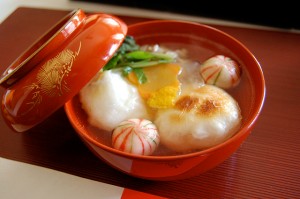
Zoni is a savory vegetable soup with mochi inside that is eaten around New Years. The soup base varies by region; in Kanto it is made with a clear broth while in Kansai it is made from white miso. The size and shape of the mochi used also depends on where it is being made.
Kinako Mochi きな粉餅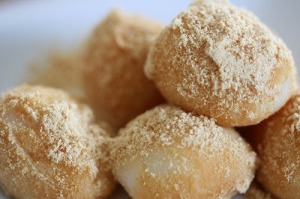
This is probably my favorite way to eat mochi. The dry soy bean “kinako” powder tastes very similar to peanuts, and its texture compliments the fluffy mochi perfectly. It’s a bit messy to eat though, so be sure to bring your bowl or plate close to your mouth while eating or else risk the yellow powder making an unfortunate mess on your clothes.
Zenzai ぜんざい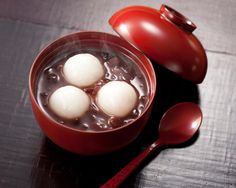
Another great mochi dish (especially in winter) is zenzai, a.k.a oshiruko. A soup-like desert made from red beans, this is the mochi for you if you have a sweet tooth. The broth is thick, with a creamy and slightly sandy texture, and comes with a couple of pieces of melted mochi hidden in the deep red, opaque liquid. It’s as much fun to play with as it is to eat.
Daifuku 大福 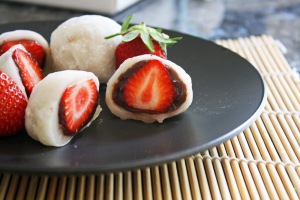
This one is a bit more of a February treat, especially the ones stuffed with whole or halved strawberries, but daifuku can be found year round, with a variety of fillings. We’ve even had daifuku in Kyoto that were stuffed with whole (though admittedly tiny) Japanese oranges. Traditional daifuku are flattened mochi blankets that are wrapped around an anko (red bean paste) filling. Since anko and mochi are both very dense and daifuku tend to come in palm sized portions, one serving is usually more than enough to fill anyone up.
Now that I’ve gotten your mouth watering with all the delicious ways one can eat mochi, it’s time to expose its dark side. Like marshmallows in the west, mochi poses a strikingly high risk of death by choking–especially among the young and the elderly. Within the first week of 2015, mochi killed at least 9 people, and sent 128 more to the hospital. Rocket News covered the whole grim story here. I recommend clicking the link, if for no other reason than to watch the strangely cheerful song at the end, about how mochi (and everything else, apparently) will kill your children and grandparents if you’re not careful.
And don’t forget to click the links in the headers to each mochi variety for recipes, if you’re interested in making mochi yourself.